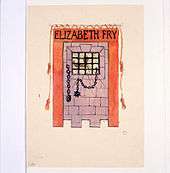Mary Lowndes
| Mary Lowndes | |
|---|---|
 Lowndes & Drury, She hath done what she could, 1901, St Peter's Church, Henfield, West Sussex. | |
| Born |
1856 Dorset, England |
| Died |
1929 Buxted, East Sussex, England |
| Education | Slade School of Fine Art |
Mary Lowndes (1856–1929)[nb 1] was a British stained-glass artist who co-founded Lowndes and Drury that built The Glass House studio. She was also a poster artist, in particular with her active participation in the suffragette movement. Lowndes was a leading light in the Arts and Crafts movement and chair of the Artists' Suffrage League (ASL).
Personal life
Mary Lowndes was born in 1856 to a Dorset clergyman.[1]
She died in 1929 and was buried in Buxted, East Sussex, England.[1]
Work
She studied art in London at the Slade School of Fine Art. After school she designed stained glass works, arranged for her own commissions, and had the works made by James Powell and Sons. Until he started his own studio, Lowndes did some work with Powell's head stained glass designer Henry Holiday. She then began work in Southwark as a stained glass artist for Britton and Gilson, a firm which developed Norman Glass, a Slab glass that was used by Christopher Whall and his followers.[1][2]
In 1897, with the then foreman of the firm, Alfred J. Drury, she founded Lowndes & Drury. In 1906 they founded the Glass House in Lettice Street, Fulham. The Glass House was established at 9, 10, 11 and 12 Lettice Street in Fulham by Mary Lowndes and A.J. Drury as a stained glass studio for works commissioned by Lowndes and Drury and use by independent artists. It was a purpose-built stained-glass studio and workshop designed by Christopher Whall and Alfred Drury.[2][3]
Lowndes designed, coloured and created Art Nouveau stained glass works. She groomed many women stained glass designers and artists, such as Wilhelmina Geddes who was a lesbian like Lowndes. The Glass House attracted many artists, like Geddes, Whall, Robert Anning Bell and many more. The artists could leverage the skills of other artists at the studio and yet obtain their own commissions. Lowndes' partner, Alfred Drury particularly focused on the creation of stained glass pieces. Together they commissioned for design, painting and creation projects.[1][2]

Suffragette movement
In January 1907, Lowndes established The Artists' Suffrage League (ASL) to create dramatic posters, postcards, Christmas Cards, and banners for suffrage events. She became its chair.[4]
Artwork by Lowndes and The Artists' Suffrage League may be seen at The Women's Library at the Library of the London School of Economics.[4][5] Even underwear in suffragette colours appeared in stores. Between 1903 and 1914 the methods used by the women's suffrage movement began to change and they began to engage in public demonstrations and other propaganda activities. Lowndes' training as a stained-glass designer encouraged the use of bold shapes and a love of full, rich colours, using striking combinations of green and blue, magenta and orange.[4]
Lowndes was also active in the national Suffragette movement, including her leadership on the National Union of Women's Suffrage Societies executive committee.[6]
Stained glass
The following is a partial list of her works and that she did as part of the Lowndes and Drury partnership.
- All Saints' Church, Childwall
- St George's Church, Altrincham
- St Andrew, Boxford, Berkshire
- St Mary, Ewshot
- St Mary's, Welwyn
- All Hallows, Gospel Oak, London
- St Mary, Pimlico, London
- St. Yeghiches (Armenian), Kensington, London
- St John the Baptist, Wittersham
- St Leonard, Heston, London
- St Peter, Great Cheverell, Wiltshire
- St Peter, Henfield, Sussex
- St Mary and St Blaise, Boxgrove, Sussex
- St Christopher, Haslemere
- St Andrew's, Meonstoke
- St Mary, Linton, Cambridgeshire
- St Peter, Shropham, Norfolk
- Holy Innocents, Lamarsh, Essex (a scheme of three windows over several years)
- St John the Baptist, Snape
Gallery
-

Mary Lowndes, The church of SS Peter and Paul in Shropham, an early work
-

Mary Lowndes, The church of SS Peter and Paul in Shropham, an early work
-

Lowndes & Drury, English stained glass, 1912, Taplow, Buckinghamshire
Notes
- ↑ Some sources put her birth in 1857.
References
- 1 2 3 4 Architects and Artists L: Lowndes and Drury. Sussex Parish Churches. Retrieved 10 September 2012.
- 1 2 3 Emmanuel Cooper, "The sexual perspective: homosexuality and art in the last 100 years in the West” Routledge and Kegan Paul Ltd 1986, London
- ↑ The Glass House, Hammersmith and Fulham. British Listed Buildings. Retrieved 10 September 2012.
- 1 2 3 Lisa Tickner "Banners and Banner-Making". In Vanessa R. Schwartz and Jeannene M. Przyblyski, "The Nineteenth Century Visual Culture Reader". Routledge, 2004, London and New York.
- ↑ Home. London School of Economics. Retrieved 16 July 2013.
- ↑ Lago, Mary. (1995). Christiana Herringham and the Edwardian Art Scene. University of Missouri Press. p. 287 ISBN 0826210244
Further reading
- M. Lowndes: Banners and Banner-Making, Appendix 5 in The Spectacle of Women by Lisa Tickner, University of Chicago Press. ISBN 978-0-226-80245-9 March 1988.
- Gerda Breuer and Julia Meer: Women in Graphic Design, Jovis/Berlin 2012, ISBN 978-3-86859-153-8, p. 505.